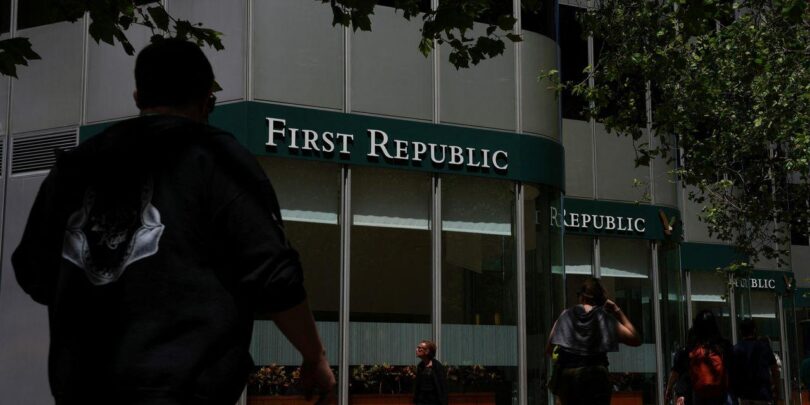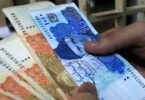NEW YORK (CNN): Federal regulators are holding an auction for ailing regional bank First Republic, a person familiar with the matter tells CNN.
Final bids are due for First Republic Bank at 4 p.m. ET on Sunday, the source said.
The Federal Deposit Insurance Corporation, the independent government agency that insures deposits for bank customers, is running the auction.
Neither First Republic nor the FDIC were immediately available for comment.
A decision on a First Republic buyer would seem likely to be announced later Sunday evening. During times of market stress, government officials typically try to announce solutions before global markets start trading. Some Asian markets are scheduled to begin trading at 8 p.m. ET Sunday.
Shares of First Republic (FRC) plunged from $122.50 on March 1 to around $3 a share as of Friday on expectations that the FDIC would step in by end of day and take control of the San Francisco-based bank, its deposits and assets. But that never happened.
The FDIC had already done so with two other similar sized banks just last month — Silicon Valley Bank and Signature Bank — when runs on those banks by their customers left the lenders unable to cover customers’ demands for withdrawals.
The Wall Street Journal previously reported that JPMorgan Chase and PNC Financial are among the big banks bidding on First Republic in a potential deal that would follow an FDIC seizure of the troubled regional bank.
PNC declined to comment. JPMorgan did not respond to requests for comment.
“We are engaged in discussions with multiple parties about our strategic options while continuing to serve our clients,” First Republic said in a statement Friday night.
If there is a buyer for First Republic, the FDIC would likely be stuck with some money-losing assets, as was the case after it found buyers for the viable portions of SVB and Signature after it took control of those banks.
A kind of shotgun marriage, arranged by regulators who didn’t want a significant bank to end up in the hands of the FDIC before it was sold, occurred several times during the financial crisis of 2008 that sparked the Great Recession. Notably, JPMorgan bought Bear Stearns for a fraction of its earlier value in March of 2008, and then in September bought savings and loan Washington Mutual, soon after Bank of America bought Merrill Lynch.
The failure of Washington Mutual in 2008 was the nation’s largest bank failure ever. First Republic, which is bigger than either SVB or Signature Bank, would be the second largest.
First Republic lifeline proved not to be enough
Soon after collapses of SVB and Signature in March, First Republic received a $30 billion lifeline in the form of deposits from a collection of the nation’s largest banks, including JPMorgan Chase (JPM), Bank of America (BAC), Wells Fargo (WFC), Citigroup (C) and Truist (TFC), which came together after Treasury Secretary Janet Yellen intervened.
The banks agreed to take the risk and work together to keep First Republic flush with the cash in the hopes it would provide confidence in the nation’s suddenly battered banking system. The banks and federal regulators all wanted to reduce the chance that customers of other banks would suddenly start withdrawing their cash.
But while the cash allowed First Republic to make it through the last six weeks, its quarterly financial report Monday evening, with the disclosure of massive withdrawals by the end of March, spurred new concerns about its long-term viability.
Nervous major depositors
The financial report showed depositors had withdrawn about 41% of their money from the bank during the first quarter. Most of the withdrawals were from accounts with more than $250,000 in them, meaning those excess funds were not insured by the FDIC.
Uninsured deposits at the bank fell by $100 billion during the course of the first quarter, a period during which total net deposits fell by $102 billion, not including the infusion of deposits from other banks.
The uninsured deposits stood at 68% of its total deposits as of December 31, but only 27% of its non-bank deposits as of March 31.
In its earnings statement, the bank said insured deposits declined moderately during the quarter and have remained stable from the end of last month through April 21.
Banks never have all the cash on hand to cover all deposits. They instead take in deposits and use the cash to make loans or investments, such as purchasing US Treasuries. So when customers lose confidence in a bank and rush to withdrawal their money, what is known as a “run on the bank,” it can cause even an otherwise profitable bank to fail.
First Republic’s latest earnings report showed it was still profitable in the first quarter — its net income was $269 million, down 33% from a year earlier. But it was the news on the loss of deposits that worried investors and, eventually, regulators.
While some of those who had more than $250,000 in their First Republic accounts were likely wealthy individuals, most were likely businesses that often need that much cash just to cover daily operating costs. A company with 100 employees can easily need more than $250,000 just to cover a biweekly payroll.
First Republic’s annual report said that as of December 31, 63% of its total deposits were from business clients, with the rest from consumers.
First Republic started operations in 1985 with a single San Francisco branch. It is known for catering to wealthy clients in coastal states.
It has 82 branches listed on its website, spread across eight states, in high-income communities such as Beverly Hills, Brentwood, Santa Monica and Napa Valley, California; in addition to San Francisco, Los Angeles and Silicon Valley. Outside of California, branches are in other high-income communities such as Palm Beach, Florida; Greenwich, Connecticut; Bellevue, Washington; and Jackson, Wyoming.







